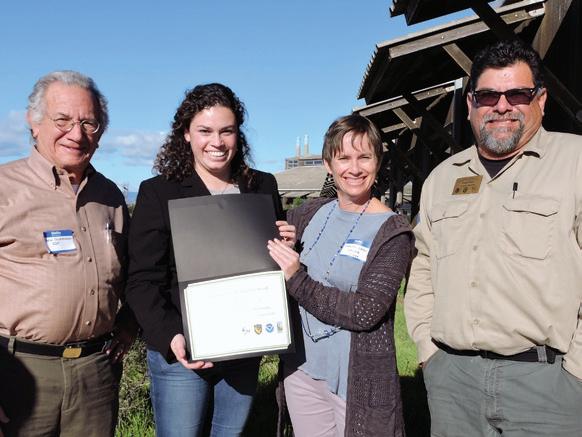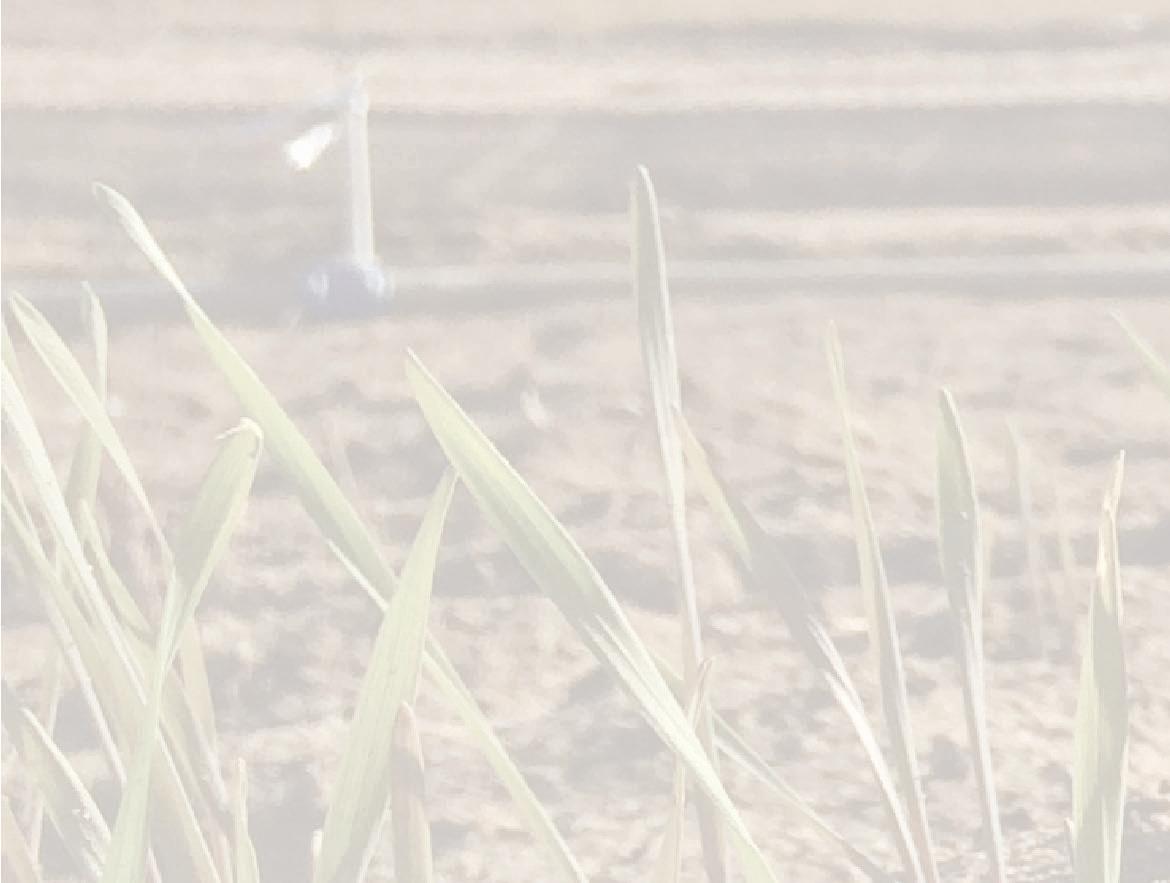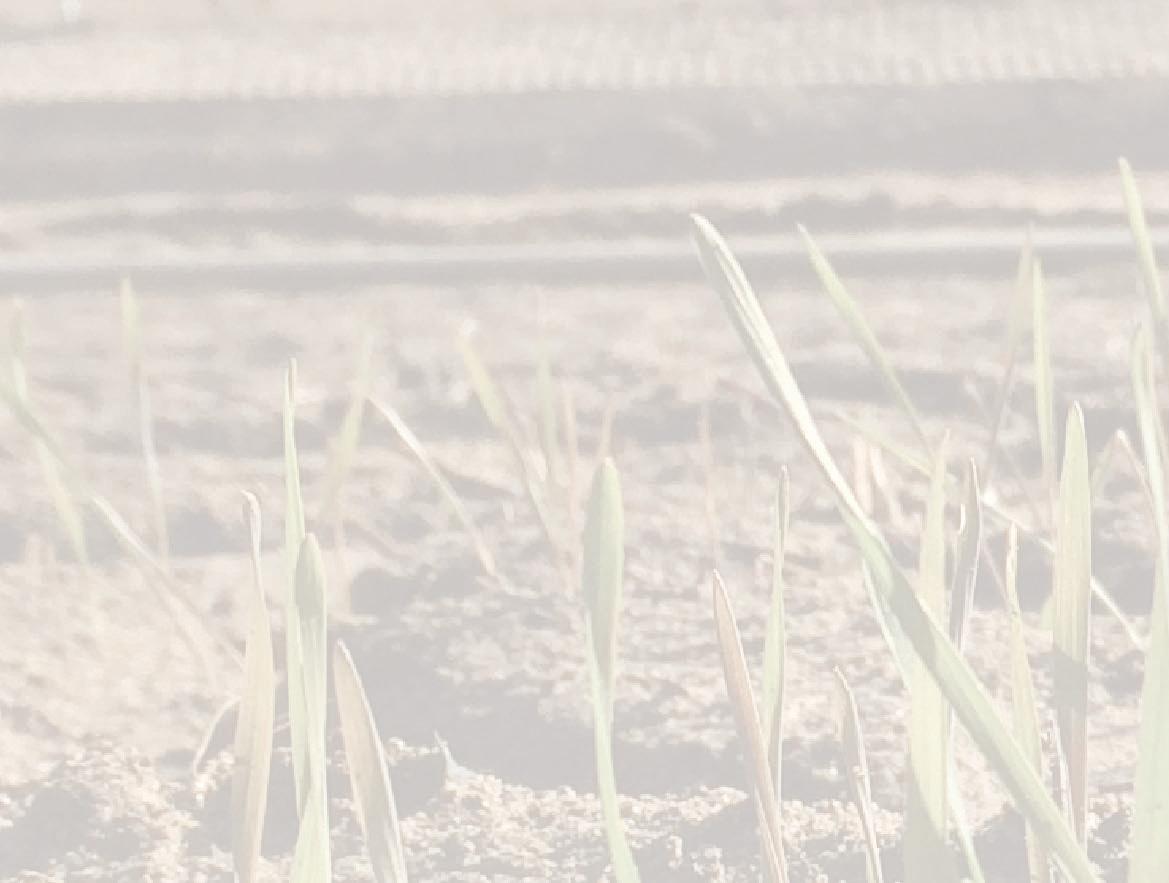Tidal Exchange



6 months later…







6 months later…



Land restoration is a long-term commitment. Even under the best conditions, the process can take seven to ten years, phased according to land conditions and speci c conservation goals. ESF’s rst priority at Sand Hill Farm — purchased in June 2016 through a grant from the California State Coastal Conservancy — has been to limit erosion to prevent seasonal rains from draining sediment and runo into the estuary.
e 107-acre property, which was formerly cultivated in strawberries, contained tons of agricultural plastic and trash that was supposed to be removed before close of escrow. But just weeks before Sand Hill Farm was transferred to ESF, we learned the cleanup of the property had not been completed. Acres of agricultural plastic, drip tape, and furrows were left behind, overgrown with weeds. is all needed to be removed before grading the steep hillsides and planting cover crops to anchor the loose soil in place. If the cover crop was not in place by early October, winter storms could again wash sediment into the neighboring wetlands.
On New Year’s morning, a rainbow touched down on Sand Hill Farm — an inspiring symbol of a fresh start for the steep slopes that once drained sediment into the slough with each winter storm.
With little more than three months to prepare the 107-acre property for winter rains, we had a decision to make: act now or risk runo throughout another winter.
Faced with this choice, ESF made the strategic decision to take on the massive cleanup job itself — as an investment in the future of Sand Hill Farm and the health of the slough. ough additional donations would be crucial to supporting the cleanup, we recognized the importance and urgency of preparing the land for the rainy season. ere was no time to waste.
Within weeks of taking ownership, ESF brought in hardworking restoration crews from the California Conservation Corps (CCC) to help remove weeds and agricultural trash. ese hardy workers, properly equipped to labor in rough terrain, were invaluable help in removing brittle drip tape, plastic sheeting, and weeds from the steep elds. In two weeks
Elkhorn Slough Foundation
Anne Olsen
President
Judith Connor
Vice President
C. Michael Pinto
Treasurer
Robert Hartmann
Secretary
Steven Webster
Past President
Ed Boutonnet
Sandy Hale
Kent Marshall
Anne Secker
Murry Schekman
Bruce Welden
Mary Wright
Mark Silberstein
Executive Director
e mission of the Elkhorn Slough Foundation is to conserve and restore Elkhorn Slough and its watershed.
We see Elkhorn Slough and its watershed protected forever— a working landscape, where people, farming, industry, and nature thrive together. As one of California’s last great coastal wetlands, Elkhorn Slough will remain a wellspring of life and a source of inspiration for generations to come
PO Box 267, Moss Landing California 95039
tel: (831) 728-5939
fax: (831) 728-7031
www.elkhornslough.org
Scott Nichols, Editor
Elkhorn Slough Foundation
Tidal marshes perform a variety of natural services that bene t nearby communities — protecting people and property against storm surges and ooding, improving water quality, and providing habitat for commercially important sh and wildlife.
For millennia, most marshes have kept pace with rising seas by increasing in elevation. With sea levels projected to increase much faster in the future, the fate of many marshes is now uncertain.


In a pioneering study conducted at 16 sites in 13 coastal states, National Estuarine Research Reserve scientists evaluated the ability of tidal marshes to “bounce back” as sea levels rise, evaluating ve categories of resilience: marsh elevation, change in elevation, sediment supply, tidal range, and rate of sea level rise. e ndings, published in Biological Conservation, suggest that marshes along the Paci c Coast are more likely to survive than those along the Atlantic.
“Overall, Elkhorn Slough’s tidal marshes scored as moderately resilient, yet the study highlighted signi cant risks in the category of elevation change,” said Elkhorn Slough Reserve Research Coordinator Kerstin Wasson, a lead author of the study. “Our marshes are not matching current rates of sea level rise, which spells real trouble for the near future as the pace of sea level rise accelerates. Without investing in marsh restoration, the slough’s salt marshes may drown.” •
Reserve Research Coordinator Kerstin Wasson will discuss a critical habitat in the estuary: salt marsh. Kerstin will examine the value of tidal marshes to wildlife and humans, the threats Elkhorn Slough's marshes face, and what they need to survive. For more information, visit elkhornslough.org or call the Reserve Visitor Center at (831) 728-2822.
February 9, 6 – 7pm | Elkhorn Slough Reserve FREE & OPEN TO THE PUBLIC!














On January 24, more than 100 researchers, professors, students and conservation specialists gathered to share their ndings at the 2017 Elkhorn Slough Research Symposium, co-hosted by the Elkhorn Slough National Research Reserve and the Elkhorn Slough Foundation at Moss Landing Marine Labs.

(l to r) ESF Executive Director Mark Silberstein, awardee Sarah Espinosa, ESNERR Research Coordinator Kerstin Wasson, and Reserve Manager Dave Feliz
“ e Symposium is a wonderful way for scientists working on a range of di erent questions to exchange ideas and learn from each other,” says Reserve Research Coordinator Kerstin Wasson.
Presentations explored a variety of coastal ecosystems, and topics ranging from sea otters to oyster restoration and from water quality to climate adaptation. Another highlight: the Elkhorn Slough Conservation Research Award was presented to UC Santa Cruz graduate student Sarah Espinosa for science and leadership with the collaborative Elkhorn Slough Sea Otter Project (see page 6) •
Our 2017 Evenings at the Estuary lineup includes topics that highlight the diverse coastal habitats the Elkhorn Slough Reserve and ESF work to protect.
In May, we'll welcome green grass, wild owers, and new calves with a talk about how cattle can enhance conservation e orts in coastal prairie — one of the most threatened habitats in California.
In August, we'll dive into the world of whales, listening to their songs and learning about the di erent species that inhabit the Monterey Bay.
Of particular interest to watershed locals, our November talk will focus on approaches to managing eucalyptus trees, featuring local experts in re safety and land management. Throughout the upcoming months, more information will be posted at elkhornslough.org. •

As an Education & Visitor Services Programs Coordinator for the Reserve, Virginia Guhin spends her time seeking ways to bring students and teachers to the Reserve and to inspire a love of nature. In 2015, Virginia developed the Estuary Explorers Club, an afterschool program for 1st – 5th grade students at nearby Elkhorn Elementary.
“ e Estuary Explorers program allows us to build a relationship with our local kids and their families, while instilling an appreciation for the Elkhorn Slough environment in these young stewards,” says Reserve Manager Dave Feliz. “I look forward to the boundless energy and curiosity that arrives every Wednesday afternoon with the Elkhorn Elementary School bus.”
In October, the California Department of Fish & Wildlife recognized Virginia’s accomplishments with the 2016 Employee Excellence Award for Vision in an award ceremony held in Sacramento. Employee Excellence Awards recognize employees for work that exempli es the core values of the department.

“A program like Estuary Explorers allows a group of local students to visit the Reserve once a week for four years. It is through this deep experience that new stewards of the Reserve emerge and grow,” Virginia says. “It’s been an honor to be recognized by the department and my peers for doing what I truly enjoy.”
It speaks for the Department of Fish & Wildlife that they recognized Virginia’s vision and persistence and it speaks volumes for Virginia and the Reserve to be looking for new and creative ways to share the slough. Congratulations, Virginia! •

of work under the hot sun, the crews were able to clear almost 21 acres — promising, though still just a beginning. Nothing worthwhile comes easy, as the saying goes. Toward the end of July, the CCC crew was pulled away to help ght wild res raging along the Big Sur coast and in the Santa Cruz Mountains. Still up against the clock, ESF’s land team persevered in the cleanup of Sand Hill Farm, while reaching out for much-needed help from contract laborers and volunteers.



Before long, ESF’s land team was working with volunteers, individuals and groups — from community volunteers to international ecotourism activists, from college classrooms to corporate programs — who rolled up their sleeves to build momentum in restoring Sand Hill Farm.

On September 30, the last dumpster of the season was hauled away. Heavy equipment arrived to re-contour the property — grading worn agricultural elds, lling erosion gullies, and preparing sediment basins to capture storm runo .

50 acres re-contoured

Local employee volunteers from Keurig Green Mountain removed nearly 1,500 feet of wildlife exclusion fencing and 12–15 cubic yards of additional agricultural trash. Conservation volunteers from the USA and abroad joined with our neighbors, Stanford undergraduates from Hopkins Marine Station, our North Monterey County High School Slough Crew members and others to remove drip tape and recycle old irrigation pipes. anks to the enthusiastic energy of volunteers and the expertise of our land team and skilled contractors, more than 70 tons of trash — including seventeen 40-yard dumpsters of agricultural plastic, drip tape, and other garbage — were removed from the landscape.
e irrigation system was repaired, more than three tons of Merced rye seed were sowed and 512 bales of weed-free straw spread to secure the soil from erosion.
All before the winter rains arrived.
In late October, the rst autumn rains fell and Sand Hill Farm had its rst real test. Would these rst-year erosion control measures substantially reduce sediment runo to the slough? After 1 ½ inches of rainfall, the results were encouraging: a 90% decrease in erosion and runo , according to a colleague with the USDA Natural Resources Conservation Service.
6,500 lbs of cover



Our land team surveyed the land and quickly went to work repairing rivulets that might signal emerging gullies, spreading straw and setting ba es to absorb and redirect runo , and broadcasting cover seed over areas that had been damaged or needed additional protection from impending storms.
On the morning of New Year’s Day, a rainbow arched over Elkhorn Slough to touch down on the green hillsides of Sand Hill Farm — an inspiring symbol of a fresh start for the steep

300+ volunteer hours




slopes that, for years, su ered massive runo and erosion with each winter storm and drained sediment into the Elkhorn Slough Reserve and its wetlands.
e series of severe storms in early January that caused gullies, slides, and ash ooding throughout the Central Coast (and even forced hard closures of Elkhorn Road just south of the Reserve and to the north at Kirby Park) also challenged some of the infrastructure we prepared to protect Sand Hill Farm. Our catchment basins were lled to capacity and some of the hillsides, saturated by unrelenting rains, su ered more gullying than anticipated. So far, though, our e orts have prevented sediment from fanning from the hills into the slough below, and neighbors and agency o cials alike have praised our progress.







mountain of plastic, only to discover at least two more caches buried below the ridgeline. To remain on schedule, we had to leave this newly discovered plastic where we found it, knowing we would have to retrieve and remove it next season under drier conditions.
Even that isn’t the end of the work. e steepest slopes, now taken out of production, will be returned to the native oak woodland, coastal scrub, and chaparral that thrived on these hills decades ago. at means hundreds of native wild owers, trees and grasses need to be grown, nurtured, and planted with the help of many volunteers.



In six months, the progress we made has been substantial, breathtaking and quite visible. It can be tempting to imagine we are inches from the nish line, though in truth, we have barely left the starting blocks. With heroic e orts and heartening successes, our work at Sand Hill Farm is just beginning. We’re still learning the lay of the land.
For instance, days before the cover crop needed to be seeded, ESF sta member Kevin Contreras found buried stockpiles of old plastic. ESF managed to remove an enormous
On lower, less steep sections of the land, an organic farm must still be created. We need to design a farm footprint that will sustain our goals to protect habitat, prevent runo , and sustain the ecological and economic health of this dynamic watershed.
When all is said and done, this once worn-out sand hill farm will provide habitat for birds and wildlife, and nourish the community with healthy food and pro table farming. is land stands ready to become a gateway for visitors to the Elkhorn highlands — and to generations of students and nature lovers to come.
ESF is experienced at this work and we know how to do it. We know it takes time — years really. And we know it takes the support of our donors and community. Most of all, we know it’s worth it.


“We’re grateful for the help that has allowed us to make such astounding progress this season,” says ESF Executive Director Mark Silberstein. “Of course, this is only the rst year in a decade-long restoration e ort, with much work ahead of us. We’re learning from Sand Hill Farm, adapting to each challenge with growth in our knowledge, resources, and imagination.”
You can help today by sharing this story, volunteering, and supporting us with your contributions as a member of the Elkhorn Slough Foundation. Be part of the transformation at www.elkhornslough.org.

When Reserve volunteers Ron Eby and Robert Scoles began collecting data on Southern sea otters in the slough, they had no idea how their interest and enthusiasm would impact sea otter research and conservation. eir observations helped spark the Elkhorn Slough Sea Otter Project — a three-year collaborative study launched in September 2013 led by the US Geological Survey, UC Santa Cruz, the California Department of Fish & Wildlife, the Monterey Bay Aquarium, and the Elkhorn Slough National Estuarine Research Reserve.





e study examined the distribution, diet, activities, and health of 20 tagged sea otters, along with other sea otters living in the slough. e project was designed to determine how sea otters are using estuary habitats and prey resources, to understand their role in the food web, and to quantify the e ects of human-caused stressors (such as contaminants or nutrient inputs) on sea otters in Elkhorn Slough. Ultimately, the ndings will help conservation scientists and wildlife managers support the recovery of Southern sea otters in California, at the Elkhorn Slough and beyond.

A tremendous amount of data has been collected that will undoubtedly take years to analyze. And, though the collaborative Elkhorn Slough Otter Project o cially ended in September 2016, Reserve volunteers will continue to follow the radio-tagged otters for the next year or so, or until the remaining transmitters no longer function.



e Reserve volunteers hope to gather data that will address important questions that were not answered by the collaborative study. For example, with more than 100 sea otters here now, each eating around a quarter of their weight daily, a key question is “How many otters can the Elkhorn Slough support?”

Already, researchers have noted signi cant di erences between the activities of sea otters in the estuary compared to otters living on the open coast. Otters in the slough spent signi cantly less time foraging for prey and more time resting than their coastal counterparts, and were often observed hauling out on the pickleweed marsh — saving energy and warmth with a behavior unavailable to coastal otters.
e project included daily monitoring, bimonthly distribution surveys, and quarterly activity budgets (in which each individual otter is followed for 12 hours, noting location and activity every ten minutes). In addition, more than 21,000 foraging dives were monitored — documenting location, prey, time on the surface eating and time underwater nding prey for each dive.





With its dedicated team of researchers and citizen scientists, the Reserve’s monitoring program will undoubtedly shed light on this question, and continue to inspire innovative research, community partnerships.
Although the frequency and timing of monitoring e orts may change in the future, “otter spotting” is now integral to the Reserve’s conservation plan. Find out how you can be a part of these e orts at elkhornslough.org. •






Dr. Tom Williams, who served two terms on the ESF Board of Directors, passed away on January 26, 2017. His commitment to conserving the Elkhorn Slough is a legacy to us all.
For more than 30 years, “Dr. Tom” ran a busy veterinary practice in Monterey. As a research scientist for the Monterey Bay Aquarium, he initiated the Sea Otter Rescue Program and was veterinarian for the Tuna Research and Conservation Center. Since 2009, Tom served on ESF’s board, applying his expertise to protect wildlife habitat and water quality in the Elkhorn Slough.
“Tom’s humor and feisty spirit will be missed," said Executive Director Mark Silberstein. “He was a champion of the slough and a pioneer in the study and care of sea otters, the rst veterinarian to work with the Aquarium on the rescue and rehabilitation of stranded animals.” •

Have you checked the Elkhorn Slough OtterCams lately? If not, we encourage you to visit today! Recently a Southern sea otter gave birth and, moments later, we welcomed the new arrival on Facebook Live, streaming video of mom cleaning and u ng her newborn pup. (You can view a recording of the live event on the Elkhorn Slough Foundation Facebook page, where you can also follow us for noti cations and updates.)
Reserve researchers and citizen scientists use OtterCam sightings to locate tagged otters, track the growth and health of pups, and capture video to share with fellow researchers — providing a nonintrusive way to gather visual data on the otters and their activities.

Perhaps as importantly, the Elkhorn Slough OtterCams are key outreach tools, allowing us to stream rarely seen sea otter interactions, as they happen, to viewers and classrooms around the world. anks in part to a grant from the Sea Otter Foundation & Trust (SOFT), we’re working on even better picture quality and adding streaming audio, so you can hear the sounds of the slough, too.
As you scan the marshes for cute sea otters frolicking in the pickleweed, you might even catch a glimpse of Sand Hill Farm in the distance. We hope our restoration e orts — with luscious cover crops on carefully graded slopes, keeping sediment and fertilizers from entering the slough — make for some very happy animals in the estuary.
Don’t take our word for it, though … see for yourself at elkhornslough.org/ottercam. •





ough of course sea otters (especially pups) are the main attraction, the high-de nition Elkhorn Slough OtterCams also o er glimpses of the amazing restoration progress at ESF’s Sand Hill Farm.
P.O. Box 267
Moss Landing, CA 95039
Elkhorn Slough Reserve is open to the public Wednesday through Sunday, 9 am to 5 pm. We hope you’ll join us for a visit or an event. For more information, visit www. elkhornslough.org.
Every Saturday & Sunday: Reserve Tours Join knowledgeable docents for tours of the Reserve at 10 am & 1 pm
First Saturday of every month, 8:30am: “Early Bird” Walks With local birding expert Rick Fournier. Meet at the Reserve at 8:30 am
Second Sunday of every month, 2pm: “Slough & Easy” Walks Call the Elkhorn Slough Reserve at 831.728.2822 for more information
Feb. 9 — Evenings at the Estuary: Rising to the Challenge Kerstin Wasson, PhD, discusses salt marshes and sea level rise (see page 2)
March 2017 — Teacher Workshops at the Reserve Workshops for professional educators. Visit elkhornslough.org or call the Reserve at 831.728.2822 for dates and details
Check our online event calendar for details about other upcoming walks, talks and outings — including the Mud Stomp for Snowy Plovers, Evenings at the Estuary, and ESF Spring Events!


















While planting 150 young oak saplings to restore oak woodland on our Elzas property, ESF Land Steward Ken Collins pondered how, with continued care and nurturing, each would grow to become a mighty oak. At that moment, an idea took seed.






Along with getting dirty protecting the land, Ken is a tech guy and delivered a way for you to virtually “Adopt an Oak” and watch it grow as Google Earth updates its satellite images.






Learn more at www.elkhornslough.org/membership. Adopting an oak is a thoughtful gift — for yourself or an honoree — that will bene t and beautify the Elkhorn Slough for years to come. •

Visit ElkhornSlough.org and follow us on Facebook & Twitter for news and updates on upcoming events and more!





